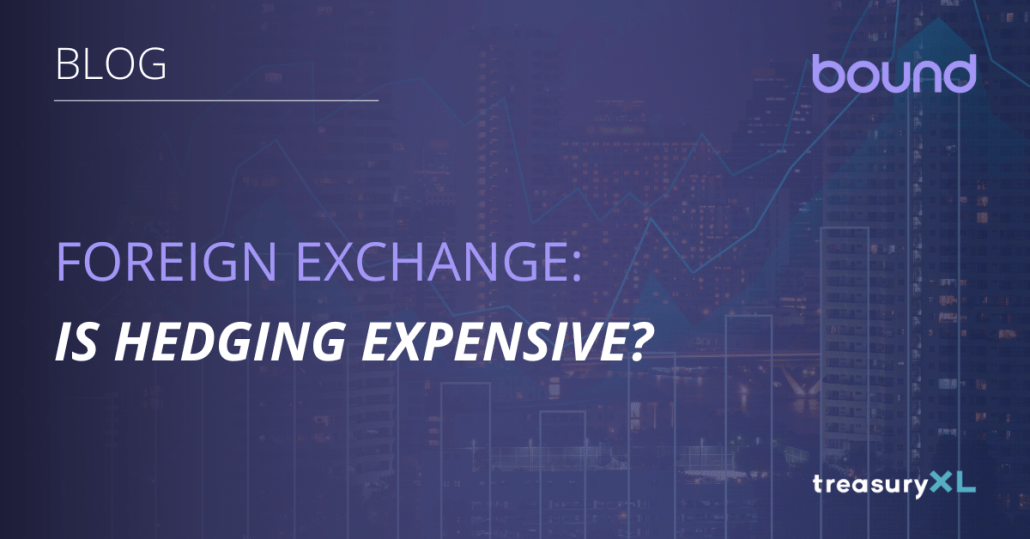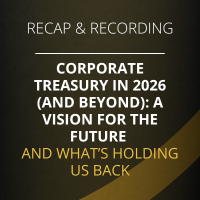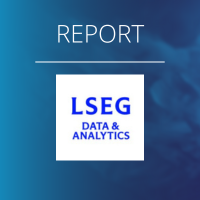FX: Is hedging expensive?
By Bound
Hedging foreign exchange risks is often perceived as expensive. However this blog by Bound argues that the costs are minimal, typically measured in basis points rather than percentages, and the benefits far outweigh the costs when compared to the volatility of spot transactions.

The myth of hedging costs
Maybe the title of this section gives away my conclusion, but here we go. Foreign exchange volatility can mess up any company’s financials. Companies not wanting to be held hostage by FX should consider hedging – i.e. taking the volatility from FX out of their finances.
What I keep hearing though is that hedging is expensive. So let’s attempt to drill down into the costs of hedging versus executing foreign exchange transactions via spot conversions.
It’s important to note that the specific components of hedging costs can vary based on the type of financial instruments being used, the markets involved, and the strategies employed. The below focuses on standard hedges via forwards and other vanilla instruments.
Transaction Costs
These are the direct costs incurred when executing a hedge, such as provider fees, commissions, and any other fees associated with trading financial instruments.
In our experience, hedging instruments are a few basis points (1 basis point = 0.01%) more expensive than spot, but in most cases well below 1% (unless you hedge with your bank and have not negotiated, or there are implications for margin postings).
Bid-Ask Spread
The bid-ask spread is the difference between the buying (bid) and selling (ask) prices of a financial instrument.
In the Interbank Market for major currency pairs, these tend to be marginal for forwards – think single digit basis points or even fractions of a basis point. Spot transactions also have bid-ask spreads, so this doesn’t usually make hedging much more expensive than spot.
Margin
If a hedge involves trading on margin, there may be interest costs associated with borrowing funds to support the margin position. Margin tends to be more of a cash flow issue rather than an actual cost for most companies.
Slippage
Slippage occurs when the execution price of a trade differs from the expected price. This can happen in fast-moving markets or due to low liquidity.
Slippage costs can contribute to overall hedging expenses, but this is usually for very large transactions or if transacting in very illiquid currencies.
Most company’s hedging transactions will fall well below the threshold where slippage applies if transacting in major currencies.
Time
Time can be a major factor to impact your hedging costs. It depends on the solutions implemented and how they are dealt with though and luckily there are providers out there that are very easy to implement and offer flexibility to adjust hedges.
Here is how I think about the time commitment buckets for hedges:
Exposure and Hedge Modeling Costs
If complex financial models or derivatives are used for hedging, there may be costs associated with developing and implementing these models. This can be mitigated by simplified exposure calculations and easy to implement and monitor hedges such as forward contracts. Once a company knows the exposure and has a hedging strategy, with solutions such as Bound, time commitment is similar to execution of spot.
Maintenance Costs
The ongoing monitoring and management of a hedge position may involve additional time. This includes the costs associated with adjusting the hedge to maintain its effectiveness over time. Again, if implemented via a self service platform, the time commitment is down to a similar amount a company would spend on ad hoc spot transactions.
Reporting Costs:
Compliance with regulatory requirements and the associated reporting and documentation procedures can contribute to the overall cost of hedging.
Conclusion
If summing up all the potential costs of hedging versus spot, we are talking about basis points rather than percentages. On the flipside, FX markets tend to move in multiple percentage points and that volatility then goes through a company’s financials. So the costs versus benefits are very limited – not enough as an excuse not to hedge.
This assumes that a company is not in the business of speculating in foreign exchange, as markets can go up as well as down. Just be aware that FX is one of the most traded capital markets and the larger players tend to be professional investors and institutions whose day job it is to trade these instruments.
Can’t get enough? Check out these latest items
 https://treasuryxl.com/wp-content/uploads/2023/03/Treasurer-Search-Logo.png
200
200
treasuryXL
https://treasuryxl.com/wp-content/uploads/2018/07/treasuryXL-logo-300x56.png
treasuryXL2025-12-30 09:19:492025-12-30 09:19:49Business Treasurer @Treasurer Search
https://treasuryxl.com/wp-content/uploads/2023/03/Treasurer-Search-Logo.png
200
200
treasuryXL
https://treasuryxl.com/wp-content/uploads/2018/07/treasuryXL-logo-300x56.png
treasuryXL2025-12-30 09:19:492025-12-30 09:19:49Business Treasurer @Treasurer Search https://treasuryxl.com/wp-content/uploads/2025/12/Copy-of-Live-Session-Nomentia-1.png
200
200
treasuryXL
https://treasuryxl.com/wp-content/uploads/2018/07/treasuryXL-logo-300x56.png
treasuryXL2025-12-19 08:49:372025-12-19 09:41:43Recap & Recording: Corporate Treasury in 2026 and beyond
https://treasuryxl.com/wp-content/uploads/2025/12/Copy-of-Live-Session-Nomentia-1.png
200
200
treasuryXL
https://treasuryxl.com/wp-content/uploads/2018/07/treasuryXL-logo-300x56.png
treasuryXL2025-12-19 08:49:372025-12-19 09:41:43Recap & Recording: Corporate Treasury in 2026 and beyond https://treasuryxl.com/wp-content/uploads/2024/01/Template_VACANCY-featured.png
200
200
treasuryXL
https://treasuryxl.com/wp-content/uploads/2018/07/treasuryXL-logo-300x56.png
treasuryXL2025-12-19 08:20:412025-12-19 08:20:41Vacancy Service Operations Manager (Treasury Tech) – Vienna
https://treasuryxl.com/wp-content/uploads/2024/01/Template_VACANCY-featured.png
200
200
treasuryXL
https://treasuryxl.com/wp-content/uploads/2018/07/treasuryXL-logo-300x56.png
treasuryXL2025-12-19 08:20:412025-12-19 08:20:41Vacancy Service Operations Manager (Treasury Tech) – Vienna https://treasuryxl.com/wp-content/uploads/2025/12/FinanceKey-Featured-1.png
200
200
treasuryXL
https://treasuryxl.com/wp-content/uploads/2018/07/treasuryXL-logo-300x56.png
treasuryXL2025-12-18 07:00:142025-12-18 18:17:55Pivoting in FinanceKey: turn raw data into instant insight
https://treasuryxl.com/wp-content/uploads/2025/12/FinanceKey-Featured-1.png
200
200
treasuryXL
https://treasuryxl.com/wp-content/uploads/2018/07/treasuryXL-logo-300x56.png
treasuryXL2025-12-18 07:00:142025-12-18 18:17:55Pivoting in FinanceKey: turn raw data into instant insight https://treasuryxl.com/wp-content/uploads/2025/08/LSEG-BLOGS-featured-10.png
200
200
treasuryXL
https://treasuryxl.com/wp-content/uploads/2018/07/treasuryXL-logo-300x56.png
treasuryXL2025-12-17 07:00:252025-12-16 08:55:07Test Data as a Service
https://treasuryxl.com/wp-content/uploads/2025/08/LSEG-BLOGS-featured-10.png
200
200
treasuryXL
https://treasuryxl.com/wp-content/uploads/2018/07/treasuryXL-logo-300x56.png
treasuryXL2025-12-17 07:00:252025-12-16 08:55:07Test Data as a Service https://treasuryxl.com/wp-content/uploads/2023/03/Treasurer-Search-Logo.png
200
200
treasuryXL
https://treasuryxl.com/wp-content/uploads/2018/07/treasuryXL-logo-300x56.png
treasuryXL2025-12-16 09:27:252025-12-16 09:27:25Interim Treasury Manager @ Treasurer Search
https://treasuryxl.com/wp-content/uploads/2023/03/Treasurer-Search-Logo.png
200
200
treasuryXL
https://treasuryxl.com/wp-content/uploads/2018/07/treasuryXL-logo-300x56.png
treasuryXL2025-12-16 09:27:252025-12-16 09:27:25Interim Treasury Manager @ Treasurer Search https://treasuryxl.com/wp-content/uploads/2025/06/Nirav-Interview-1.png
200
200
treasuryXL
https://treasuryxl.com/wp-content/uploads/2018/07/treasuryXL-logo-300x56.png
treasuryXL2025-12-16 07:00:212025-12-15 12:30:31Stablecoins: The Silent Revolution Is Already Here
https://treasuryxl.com/wp-content/uploads/2025/06/Nirav-Interview-1.png
200
200
treasuryXL
https://treasuryxl.com/wp-content/uploads/2018/07/treasuryXL-logo-300x56.png
treasuryXL2025-12-16 07:00:212025-12-15 12:30:31Stablecoins: The Silent Revolution Is Already Here https://treasuryxl.com/wp-content/uploads/2024/02/Featured_Treasurer-Search.png
200
200
treasuryXL
https://treasuryxl.com/wp-content/uploads/2018/07/treasuryXL-logo-300x56.png
treasuryXL2025-12-15 07:00:062025-12-19 08:28:55The Future of Financial Messaging: Migrating from MT940 to ISO 20022
https://treasuryxl.com/wp-content/uploads/2024/02/Featured_Treasurer-Search.png
200
200
treasuryXL
https://treasuryxl.com/wp-content/uploads/2018/07/treasuryXL-logo-300x56.png
treasuryXL2025-12-15 07:00:062025-12-19 08:28:55The Future of Financial Messaging: Migrating from MT940 to ISO 20022 https://treasuryxl.com/wp-content/uploads/2025/09/Nomentia-BLOGS-featured-5.png
200
200
treasuryXL
https://treasuryxl.com/wp-content/uploads/2018/07/treasuryXL-logo-300x56.png
treasuryXL2025-12-12 12:54:092025-12-12 13:07:57Nomentia Announces Leadership Transition to Drive Next Phase of Growth
https://treasuryxl.com/wp-content/uploads/2025/09/Nomentia-BLOGS-featured-5.png
200
200
treasuryXL
https://treasuryxl.com/wp-content/uploads/2018/07/treasuryXL-logo-300x56.png
treasuryXL2025-12-12 12:54:092025-12-12 13:07:57Nomentia Announces Leadership Transition to Drive Next Phase of Growth


